Hyundai Inster 2025 review: The plucky, affordable EV that resembles an aeroplane toilet
As sensible as wearing slippers indoors
Electric cars that can cope with journeys beyond the end of your street and back are like buses — you wait ages for one and several arrive at once. I’m being flippant, of course, as I know any electric car can handle a long journey, technically… if you have the patience.
The problem is that most people don’t, so while the likes of the Dacia Spring and Leapmotor T03 are cheap as chips, their advertised ranges of 140 miles and 165 miles respectively (less in the real world) are off-putting for most drivers.
I can hear the EVangelists screaming at their screens right now but, I’m sorry, it doesn’t matter how much anyone spouts the average daily journey distance figure (28 miles in the UK, according to the RAC Foundation), the average driver wants the reassurance that a trip of several hundred miles isn’t going to be like pulling teeth, regardless of how infrequent it might be.
That’s why electric cars like the Citroën e-C3, Renault 5 and the one you can see here, the new Hyundai Inster, are likely to do very well indeed. They’re around 50 per cent more expensive than the Spring and T03, yes, but can go almost twice as far on a charge — the Inster costs from £23,495 and can manage up to to 229 miles before needing to be plugged in (officially) — and that could put them in a sweet spot for miles per hard-earned pound. And with PCP offers starting at £249 per month, the Inster is very much within reach of most motorists.
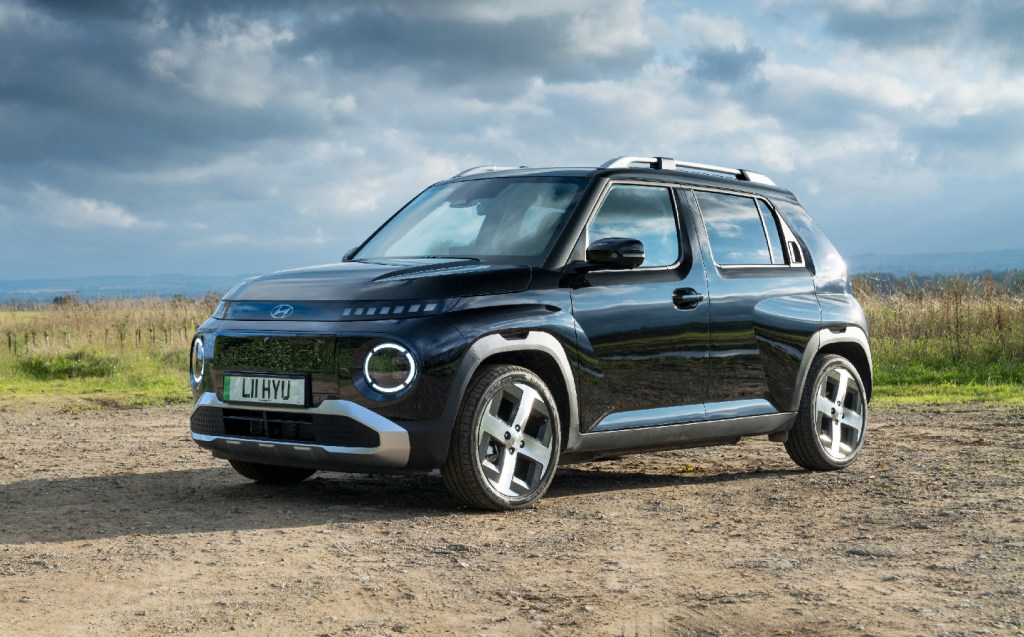
In the case of the Renault 5, taking the plunge might be a no-brainier. The Hyundai Inster is a slightly trickier proposition, though, because — and time now for some more brutal honesty — it’s far less attractive than the chic French supermini. That’s not to say the Inster doesn’t have a certain charm, but it’s like comparing a Monet with your 10-year-old’s kitchen table doodles.
The front end isn’t too bad, mind you, and the pixel light signatures do a lot to lift the appeal. But there’s no getting around the idea that there’s something a bit Popemobile about the Inster. From the rear three-quarter angle it’s more than a little reminiscent of the Suzuki Ignis, which is hardly a beauty contest winner… though, to be fair again, has its charms.
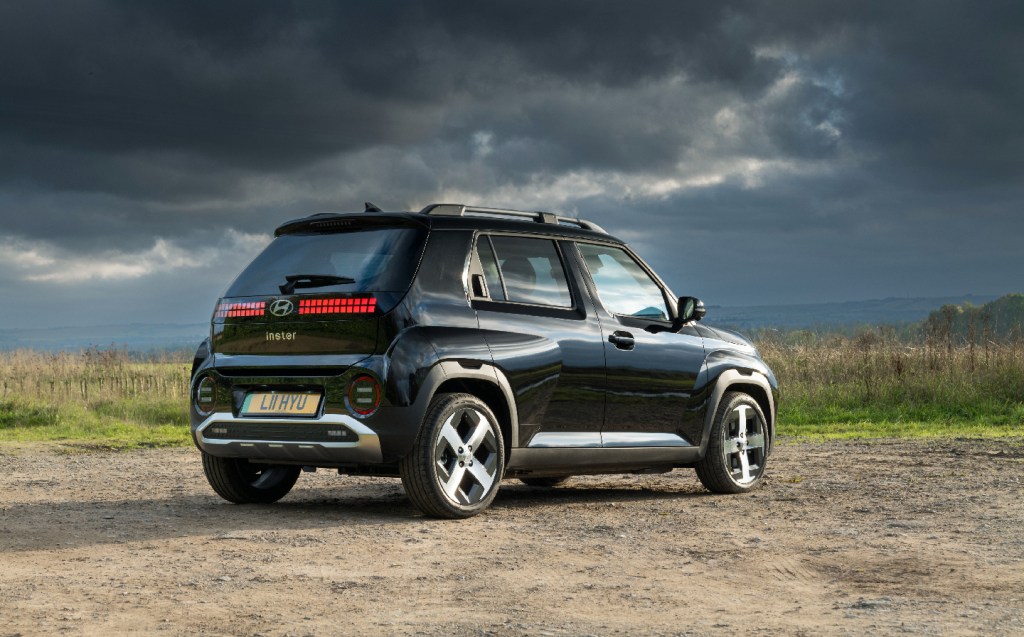
The Inster is not that much more appealing inside, from an aesthetics point of view. Hyundai says the entry-level models feature a black cloth interior but my test car had the “upgraded” beige and khaki plastic trim, which gave it the ambience of an aeroplane toilet or care home bathroom.
Still, there is a lot to like here. For a start, the Inster is a dinky little car — exactly the same length as a 2010 Nissan Micra, in fact — but while elbow room is limited for tall drivers like me, who will sit with their shoulders literally pressed against the door pillar, the high roof means there’s plenty of headroom. My legs weren’t wedged in under the steering wheel, either, so comfort for drivers of most sizes is astonishingly good.





It’s a similar picture in the back — I just about managed to fit behind the driver’s seat, when adjusted to my position, which is amazing as I’m 6ft 5in tall.
True, that ample rear kneeroom makes the boot a little small, at 238 litres — the same as a VW Up! city car — but handily you can slide the second row of seats forwards, when transporting smaller folk, freeing up as much as 351 litres for luggage.
Other good things about the new Inster include very comfortable front seats, large windows that provide plenty of light and good visibility ahead, along with a good number of physical controls, rather than relying heavily on a touchscreen. The standard kit list is decent, too; even the entry-level version comes with alloy wheels, a 10.25in digital instrument cluster and infotainment touchscreen of the same size with Apple CarPlay and Android Auto included.





My test car also featured USB, USB-C and 12v (cigarette lighter) ports above the glovebox, and down in the footwell there was also the optional high voltage socket for devices that normally work off mains electricity, including bikes, laptops and camping equipment. Because it was pre-production and left-hand drive, this had a European two-pin socket rather than a UK three-pin, but expect the latter on production cars over here.
What’s the Inster like to drive, though? Well, better than one might expect from its Lego car looks. Hyundai has based it on a Korean petrol-powered model called the Casper, which from one account I heard is a bit of a dog, but handed it to its European engineers for some tuning and the result is a car that feels confident and sure-footed on UK roads.
The Inster’s relatively lofty stance means it can straddle speed cushions (square humps) without scraping its belly, while nicely-judged suspension means potholed roads are smoothed out rather impressively, while still keeping the body movement in check.
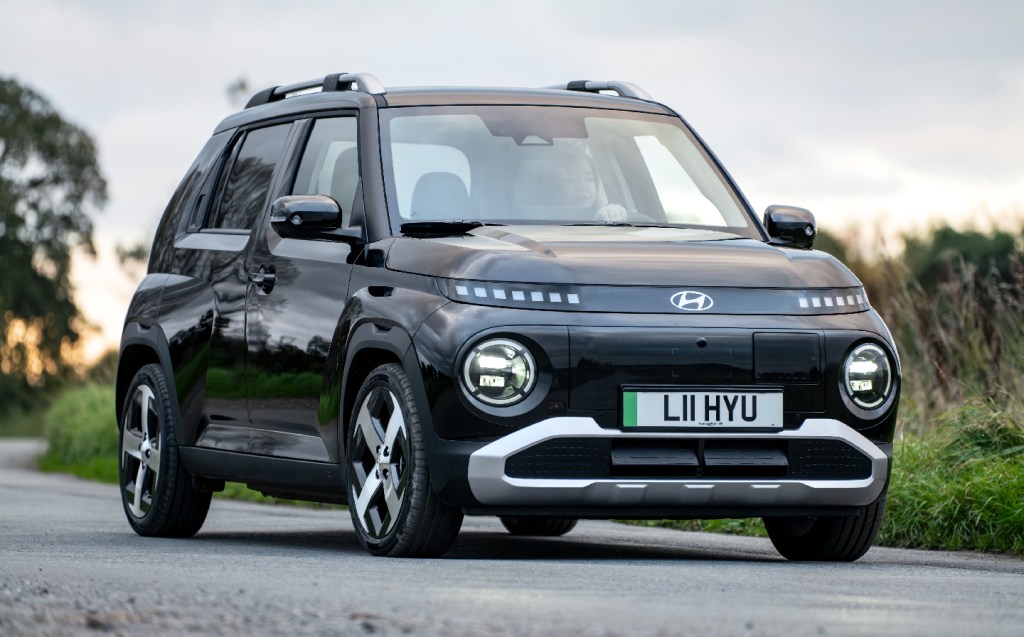
Performance depends on which size of battery you go for: the basic one with a 42kWh capacity comes with an electric motor that pumps out 95bhp, while the larger 49kWh pack is linked to a 115bhp motor.
That’s the one I tried, and acceleration could be described as perfectly adequate, with strong pull from standstill, as you’d expect from an EV. Rarely do buyers of cars like the Inster care about 0-62mph times but, for the record, it’s 10.6sec for this more powerful version. More important is the 0-30mph performance, and that’s as good as most other cars on the road.
The Inster definitely doesn’t feel sluggish but I was amused by the fact that there’s a “Sport” drive mode. Let’s be clear — the Inster is in no way sporty.
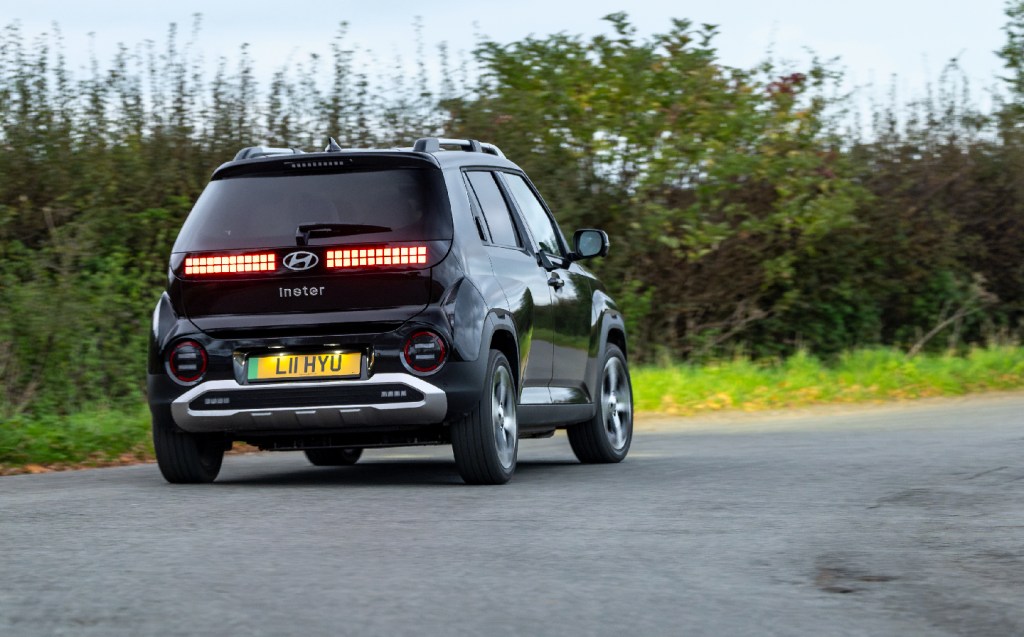
It’s not averse to taking a corner, though, and a couple of enthusiastic laps of an empty roundabout revealed the Inster can actually be rather fun, without too much body roll — no doubt thanks to the underfloor battery offering a low centre of gravity. If you get too aggressive with the accelerator pedal, the skinny front tyres can give up the ghost and the nose does start to sniff out the kerb in a fit of understeer.
That’s not a big problem, though. It’s the steering feel — or lack thereof — that lets down the Inster quite badly. Inert around the straight-ahead position and with large dollops of movement needed to corner around town, a different rack with a quicker ratio would have done the car wonders, turning the experience from a snoozefest into something mildly entertaining.
While we’re on criticisms, the wind noise around that expansive front glasshouse at higher speeds is fairly noticeable, as is the tyre noise — certainly it’s not as nicely insulated from the outside world as a Renault 5, though the Citroën e-C3 is pretty comparable.
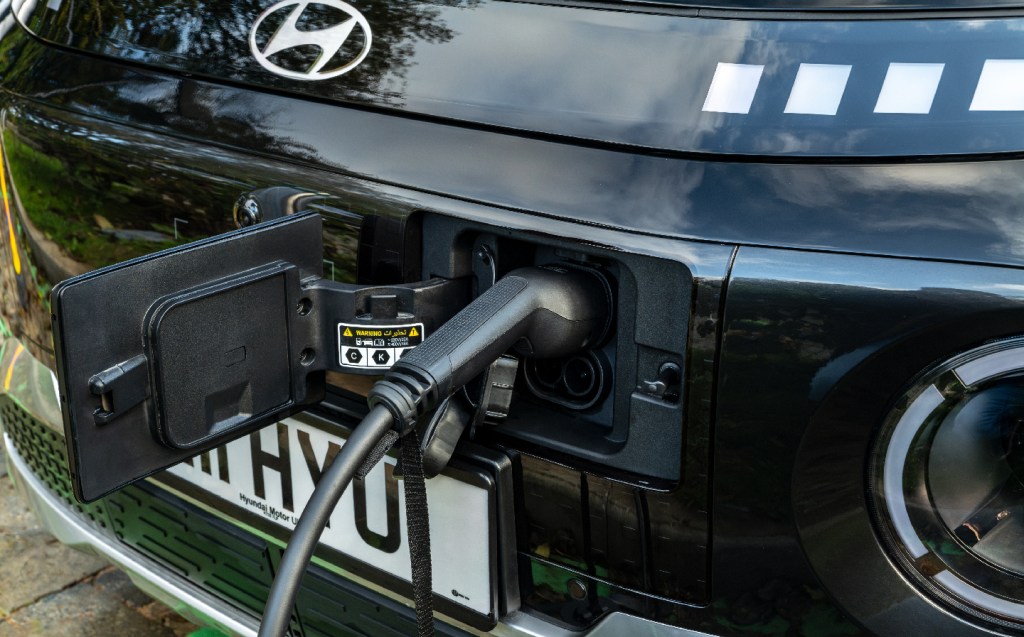
The Inster can also hold its head up when compared with the e-C3’s range and charging capabilities, with the 49kWh battery version offering 229 miles between charges in the official lab test. I drove the car in the UK in late October, and though it was a mild day, ambient temperatures could be described as fairly representative. The indicated 4.6 miles per kWh achieved over 31 miles of mixed roads is certainly efficient, and doing the maths means a real world range that isn’t at all far off the claimed figure.
It’ll also recharge relatively quickly — you can plug into a DC rapid charger and it’ll take leecy at speeds of up to 85kW, which results in a 10-80 per cent top up in 30 mins. Plug in to a home wallbox and a full charge takes 4 hrs 35 mins.
With all said and done, the Hyundai Inster is a decent package and owners will mostly be delighted with its breadth of abilities, battery size and kit levels for an EV of this price. And thank goodness these cars are finally hitting the market, as they offer drivers an affordable way into electric motoring that won’t result in a frustrating ownership experience.
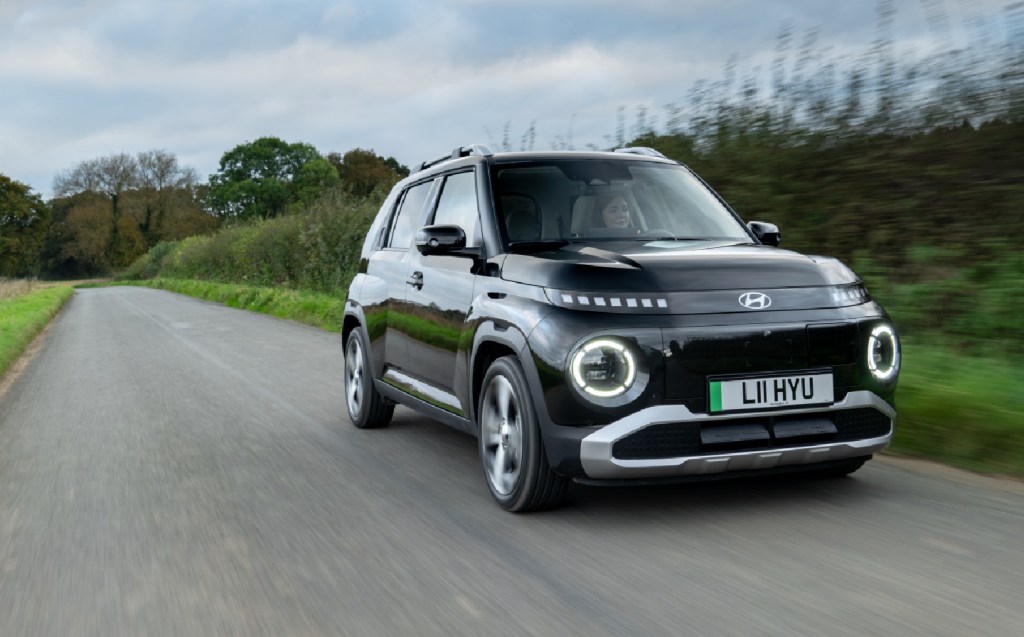
The packaging of the Inster, in particular, is really clever, but its lifeless steering and retirement-pod looks will be a deal-breaker for keen drivers and the image-conscious, especially when the (admittedly less practical) Renault 5 does such an excellent job for similar money.
Related articles
- If you enjoyed this review of the Hyundai Inster, you might like to read Will’s review of the Citroën e-C3
- Also check out the five-star Renault 5
- And here’s our review of the 2024 Hyundai Kona crossover, which comes in petrol, hybrid or pure-electric forms.
Latest articles
- Keir Starmer eases pressure on carmakers to sell EVs in response to ‘global economic headwinds’
- F1 2025 calendar and race reports: The new Formula One season as it happens
- Ferrari 12Cilindri Spider review: Heady blend of traditional and futuristic becomes even more intoxicating after lid is removed
- Skoda reveals its fastest accelerating production car yet: the electric Elroq vRS
- Carmakers fined £461m in UK and Europe for not competing over vehicle recycling
- Volkswagen Tayron 2025 review: Useful seven-seat SUV and decent PHEV — just not at the same time
- Skoda Enyaq 2025 review: Same book, different cover for electric SUV
- Lewis Hamilton wants to design a modern day Ferrari F40 with manual gearbox
- Dacia Bigster 2025 review: The ‘anti-premium’ family SUV that punches above its weight













